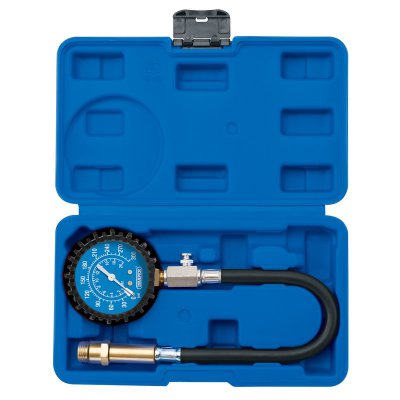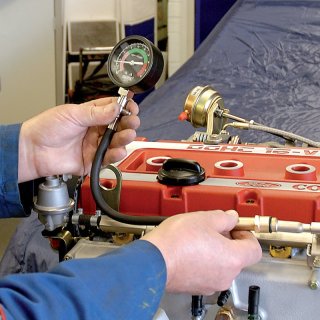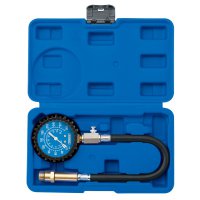DRAPER
DRAPER GASOLINE COMPRESSION TESTER
Ref: DRAP 35880 - EAN: 5010559374427
Less than 2 in stock
Delivery period:
1 day
In stock
Reflection period 14 days
Free shipping from € 50.00 (BE)
Compression tester with bleed valve to very easily measure the piston pressure in gasoline engines. The compression tester is compatible with direct and indirect gasoline engines using 14 and 18 mm spark plug wires. The dual reading pressure gauge (PSI and BAR) is equipped with a heavy-duty rubber protective cap. Tip: disconnect the ignition coil and fuel bank before starting.
Features:
- Compression tester with bleeder
- For gasoline engines
- Measuring range: 0 to 21 bar
- Measuring range: 0 to 300psi
- Hose length: 300mm
- M14 and M18
Testing method:
1. Run the engine for approx. 15 min. until it reaches its normal is operating temperature.
2. Stop the engine and disconnect all ignition wires from the spark plugs
3. Loosen all spark plugs one turn and remove all spark plugs of dirt (using a blower). Put away the removed spark plugs in the proper order.
4. Remove air filter and lock carburetor valves in maximum open position. Disconnect high voltage line from distributor and disconnect electric starter module or remove battery connections (especially on Ford V8 and V6) to prevent automatic starter.
5. Screw the spark plug adapter into the spark plug housing. Pull the adapter manually only. DO NOT USE a wrench / puller!
6. Turn on the engine or until at least four compression strokes the displayed compression tester pressure does not rise further.
7. Record the measured compression reading and repeat the action on all other spark plug devices in the engine.
Test results:
1. If the cylinder is operating normally, the needle should move with each throttle operation until the maximum is reached. All cylinders should have the values specified by the manufacturer. The values should not differ by more than 10%.
2. If the needle does not move normally or increases late, then the engine has a stuck cylinder.
3. If the measured compression pressure is many times higher than the Manufacturer indicates then carbon deposits are present in the cylinder. This can be corrected by a spark plug with higher temperature tolerance.
4. A defective cylinder head gasket shows extremely high results. Most likely you will then find water and oil are in the cylinder.
5. If the measured values are generally quite low or differ from each other, pour a teaspoon of S.A.E. 30 oil into each cylinder and test again. If the measured values remain irregular then the cylinders are defective.
6. Reconnect all ignition wires in the correct order. Return the carburetor valves to the starting position and attach the coil back to the manifold before starting the engine.
Features:
- Compression tester with bleeder
- For gasoline engines
- Measuring range: 0 to 21 bar
- Measuring range: 0 to 300psi
- Hose length: 300mm
- M14 and M18
Testing method:
1. Run the engine for approx. 15 min. until it reaches its normal is operating temperature.
2. Stop the engine and disconnect all ignition wires from the spark plugs
3. Loosen all spark plugs one turn and remove all spark plugs of dirt (using a blower). Put away the removed spark plugs in the proper order.
4. Remove air filter and lock carburetor valves in maximum open position. Disconnect high voltage line from distributor and disconnect electric starter module or remove battery connections (especially on Ford V8 and V6) to prevent automatic starter.
5. Screw the spark plug adapter into the spark plug housing. Pull the adapter manually only. DO NOT USE a wrench / puller!
6. Turn on the engine or until at least four compression strokes the displayed compression tester pressure does not rise further.
7. Record the measured compression reading and repeat the action on all other spark plug devices in the engine.
Test results:
1. If the cylinder is operating normally, the needle should move with each throttle operation until the maximum is reached. All cylinders should have the values specified by the manufacturer. The values should not differ by more than 10%.
2. If the needle does not move normally or increases late, then the engine has a stuck cylinder.
3. If the measured compression pressure is many times higher than the Manufacturer indicates then carbon deposits are present in the cylinder. This can be corrected by a spark plug with higher temperature tolerance.
4. A defective cylinder head gasket shows extremely high results. Most likely you will then find water and oil are in the cylinder.
5. If the measured values are generally quite low or differ from each other, pour a teaspoon of S.A.E. 30 oil into each cylinder and test again. If the measured values remain irregular then the cylinders are defective.
6. Reconnect all ignition wires in the correct order. Return the carburetor valves to the starting position and attach the coil back to the manifold before starting the engine.
 en
en
 Dutch
Dutch
 French
French





